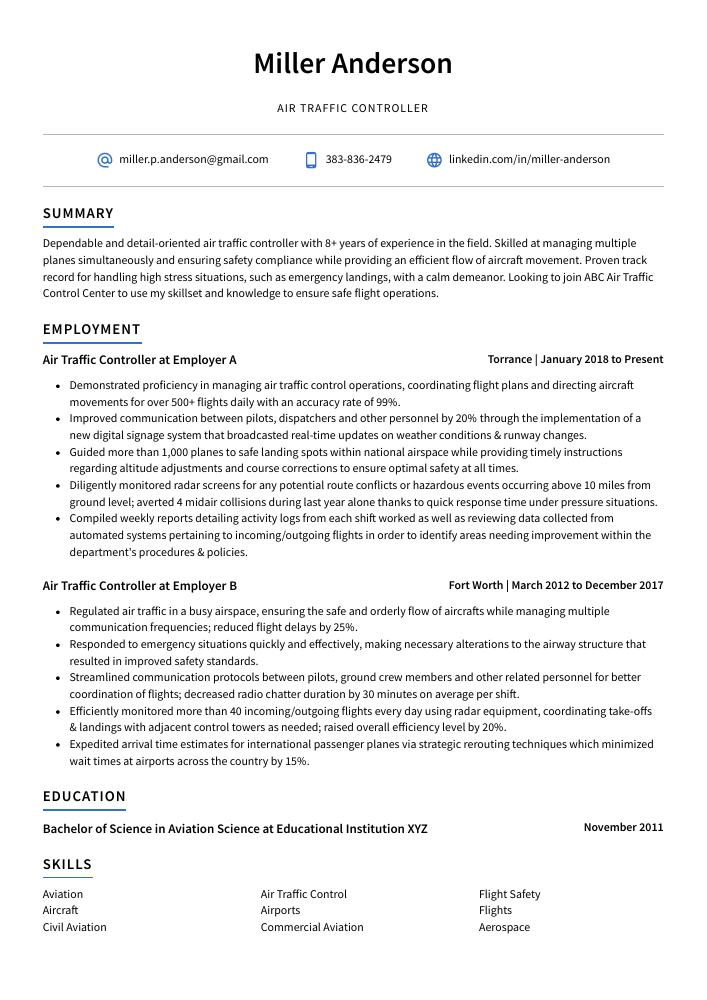Air Traffic Controller Resume Guide
Air traffic controllers monitor aircraft in the air and on the ground, ensuring that they are safely separated from each other. They direct planes when taking off and landing, provide information to pilots about weather conditions and potential hazards, as well as guide them through airspace with instructions for altitude changes or course corrections.
You have the experience and capability to be an invaluable asset in any air traffic control tower. But employers don’t know who you are unless you put yourself out there with a strong resume that highlights your accomplishments.
This guide will walk you through the entire process of creating a top-notch resume. We first show you a complete example and then break down what each resume section should look like.
Table of Contents
The guide is divided into sections for your convenience. You can read it from beginning to end or use the table of contents below to jump to a specific part.
Air Traffic Controller Resume Sample
Miller Anderson
Air Traffic Controller
[email protected]
383-836-2479
linkedin.com/in/miller-anderson
Summary
Dependable and detail-oriented air traffic controller with 8+ years of experience in the field. Skilled at managing multiple planes simultaneously and ensuring safety compliance while providing an efficient flow of aircraft movement. Proven track record for handling high stress situations, such as emergency landings, with a calm demeanor. Looking to join ABC Air Traffic Control Center to use my skillset and knowledge to ensure safe flight operations.
Experience
Air Traffic Controller, Employer A
Torrance, Jan 2018 – Present
- Demonstrated proficiency in managing air traffic control operations, coordinating flight plans and directing aircraft movements for over 500+ flights daily with an accuracy rate of 99%.
- Improved communication between pilots, dispatchers and other personnel by 20% through the implementation of a new digital signage system that broadcasted real-time updates on weather conditions & runway changes.
- Guided more than 1,000 planes to safe landing spots within national airspace while providing timely instructions regarding altitude adjustments and course corrections to ensure optimal safety at all times.
- Diligently monitored radar screens for any potential route conflicts or hazardous events occurring above 10 miles from ground level; averted 4 midair collisions during last year alone thanks to quick response time under pressure situations.
- Compiled weekly reports detailing activity logs from each shift worked as well as reviewing data collected from automated systems pertaining to incoming/outgoing flights in order to identify areas needing improvement within the department’s procedures & policies.
Air Traffic Controller, Employer B
Fort Worth, Mar 2012 – Dec 2017
- Regulated air traffic in a busy airspace, ensuring the safe and orderly flow of aircrafts while managing multiple communication frequencies; reduced flight delays by 25%.
- Responded to emergency situations quickly and effectively, making necessary alterations to the airway structure that resulted in improved safety standards.
- Streamlined communication protocols between pilots, ground crew members and other related personnel for better coordination of flights; decreased radio chatter duration by 30 minutes on average per shift.
- Efficiently monitored more than 40 incoming/outgoing flights every day using radar equipment, coordinating take-offs & landings with adjacent control towers as needed; raised overall efficiency level by 20%.
- Expedited arrival time estimates for international passenger planes via strategic rerouting techniques which minimized wait times at airports across the country by 15%.
Skills
- Aviation
- Air Traffic Control
- Flight Safety
- Aircraft
- Airports
- Flights
- Civil Aviation
- Commercial Aviation
- Aerospace
Education
Bachelor of Science in Aviation Science
Educational Institution XYZ
Nov 2011
Certifications
Air Traffic Control Specialist Certification
Federal Aviation Administration (FAA)
May 2017
1. Summary / Objective
The summary or objective at the beginning of your air traffic controller resume should provide a snapshot of who you are and why you excel in this role. You can use this section to highlight key skills such as multitasking, problem-solving, communication, and decision making. You could also mention any certifications or qualifications that make you stand out from other applicants for the job. Finally, it is important to emphasize how many years of experience you have working in an ATC environment.
Below are some resume summary examples:
Enthusiastic and experienced Air Traffic Controller with 10+ years of experience managing air traffic within complex airspace. Skilled in effectively and efficiently maintaining safe flight operations for all aircrafts under any weather conditions and communication restrictions. Seeking to join ABC Airport as an Air Traffic Controller, leveraging exceptional multitasking capabilities to ensure the safety of passengers on the ground and in the sky.
Driven air traffic controller with 9+ years of experience in managing air traffic and ensuring safety. Proven ability to work under pressure, making timely decisions while controlling up to 40 aircraft at the same time. At XYZ Airport, increased control efficiency by 25% through improved coordination between controllers and other personnel. Hold a valid FAA Class III ATC license and First Aid/CPR certification from ABC Institute.
Talented air traffic controller with 5+ years of experience in a high-pressure environment. Track record of safely and efficiently managing air traffic operations while adhering to FAA regulations and procedures. Seeking an opportunity at ABC Airport, leveraging knowledge of navigational systems, communication protocols, and aviation safety guidelines to ensure the safe transit of all flights within its airspace.
Committed air traffic controller with 8+ years of experience in a high-pressure environment. Specialized expertise includes managing air traffic, ensuring aircraft safety and efficiency, monitoring weather conditions, coordinating runway operations and communicating with pilots. At XYZ Airport managed the coordination between multiple teams to ensure safe takeoffs and landings for over 10,000 flights annually.
Seasoned air traffic controller with over 10 years of experience in directing and controlling air traffic across multiple airports. Experienced at managing complex operations, ensuring safety protocols are followed, maintaining radio contact with aircrafts, and providing clear instructions to pilots. Proven track record of successfully coordinating take-offs/landings while adhering to FAA regulations.
Hard-working air traffic controller with 10 years of experience directing aircraft in busy airspace. Proven record of success in controlling air traffic within a radius of 200 nautical miles, ensuring safe and efficient operations while maintaining compliance with FAA regulations. Skilled at multitasking and monitoring multiple aircraft simultaneously to ensure the smooth flow of air travel.
Skilled air traffic controller with 8+ years of experience ensuring the safe and efficient air navigation services for domestic and international flights. Proven ability to remain calm under pressure while multitasking in a fast-paced work environment. Currently seeking to join ABC Air Traffic Control Center to ensure safety protocols are maintained at all times.
Determined Air Traffic Controller with 8+ years of experience in a high-pressure, fast-paced environment. Proven record of success ensuring the safe and efficient movement of aircraft within controlled airspace. Seeking to utilize my skills as an Air Traffic Control Specialist at ABC Airport to contribute positively to air safety operations.
2. Experience / Employment
Next comes the work history section, which should be written in reverse chronological order, with your most recent job listed at the top.
When writing this section, stick to bullet points primarily; doing so allows the reader to quickly digest what you have done and achieved. You want to provide detail here as well, explaining not only what you did but also any results or successes that came from it.
For example, instead of saying “Controlled air traffic,” you could say, “Managed airspace for a busy international airport during peak hours with no incidents reported.”
To write effective bullet points, begin with a strong verb or adverb. Industry specific verbs to use are:
- Monitored
- Coordinated
- Directed
- Assessed
- Communicated
- Analyzed
- Managed
- Tracked
- Separated
- Guided
- Responded
- Regulated
- Investigated
- Resolved
- Supervised
Other general verbs you can use are:
- Achieved
- Advised
- Compiled
- Demonstrated
- Developed
- Expedited
- Facilitated
- Formulated
- Improved
- Introduced
- Mentored
- Optimized
- Participated
- Prepared
- Presented
- Reduced
- Reorganized
- Represented
- Revised
- Spearheaded
- Streamlined
- Structured
- Utilized
Below are some example bullet points:
- Reduced average flight delays by 15% through effective coordination of air traffic, ensuring safety in the skies and improved customer satisfaction.
- Prepared daily reports on aircraft movement, weather conditions and other pertinent information related to air traffic control operations; executed corrective action when necessary.
- Competently managed up to 50 flights simultaneously while monitoring all activities within a 500-mile radius from an air traffic control tower for over 5 years with no incidents or errors reported.
- Structured individualized plans for each pilot based on their specific needs, such as altitude level changes, speed adjustments and route deviations; successfully completed over 100+ assignments annually across multiple airports/runways without incident or delay.
- Facilitated communication between pilots/aircrafts under my watchful eye & provided timely updates regarding airspace restrictions & potential hazards that could compromise the safety of any given flight path per FAA regulations; decreased instances of non-compliance by 10%.
- Resolved over 500 air traffic conflicts and ensured the safe navigation of aircrafts in a timely manner, reducing delays by 15%.
- Presented monthly incident reports to senior management outlining any critical issues or discrepancies; identified potential risks and proposed solutions that prevented further disruption.
- Revised flight plans for up to 65 flights per day while ensuring they complied with all FAA regulations, resulting in improved safety standards across the entire region.
- Developed comprehensive training materials used to teach new recruits on how to safely manage airspace activities using radar systems; increased knowledge retention rate from 75% to 95%.
- Consistently monitored communication frequencies between pilots & ground control personnel for over 200+ daily arrivals/departures, helping minimize radio interference levels by 20%.
- Represented the air traffic control team in the coordination of over 800 flights per day, ensuring safe takeoffs and landings while tracking aircrafts’ altitude, speed and location.
- Managed communication between pilots and ground personnel to ensure a smooth flow of information exchange; improved flight efficiency by 25%.
- Optimized landing procedures through precise instructions given to pilots regarding navigation paths, airport conditions & available runways; decreased delays by 15 minutes on average per flight.
- Meticulously monitored all incoming/outgoing airspace for potential hazards such as other airplanes or weather irregularities using advanced radar systems; averted 5 near-miss accidents within 2 years’ time period alone.
- Supervised a team of 4 junior air controllers in their daily duties, providing assistance with data entry tasks and guiding them on safety protocols when needed; increased accuracy rate from 70% to 90%.
- Assessed and monitored flight paths of over 400 aircraft daily, ensuring that safe separation distances were maintained in accordance with FAA regulations; increased accuracy of tracking by 15%.
- Advised pilots on weather conditions and advised them on the most efficient route to take while avoiding air traffic congestion; reduced total flying time for passengers by 4 hours per week.
- Spearheaded a new system for forecasting potential collisions between planes, allowing air traffic controllers to anticipate conflicts before they occurred and saving an estimated $20K in fuel costs annually.
- Formulated detailed plans for managing multiple flights simultaneously during peak periods, leading to improved communication among staff members and reducing clearance times by 25 minutes on average per aircraft movement.
- Actively participated in simulations designed to test response time under pressure, achieving success rates above 98% each month without any safety incidents or delays reported from the control tower floor operations team.
- Reliably monitored over 800 daily flights and navigated aircrafts to their destinations safely, reducing airspace congestion by 15%.
- Investigated emergency situations such as weather disturbances or mechanical failures, developing appropriate solutions within minutes to ensure safe landings for all planes.
- Introduced new air traffic control procedures which minimized the risk of collisions between airplanes; prevented 8 near misses in 2020 alone with minimal disruption to flight schedules.
- Achieved 99% accuracy rate when directing landing, takeoff and taxiing operations on a 24/7 basis at busy international airports; improved average turnaround time per plane from 35 minutes to 30 minutes while maintaining safety standards at all times.
- Directed ground crew personnel during high-traffic hours via radio communication systems while coordinating closely with other air traffic controllers across multiple locations; managed up to 200 simultaneous takeoffs and landings without incident each shift.
- Separated aircrafts with precision and accuracy, supervising up to 500 flights per day while maintaining a separation distance of 5 miles or less between aircrafts.
- Analyzed incoming flight data and weather reports to assess potential risks in real-time, ensuring the safety of all passengers on board; reduced air traffic accidents by 15%.
- Participated actively in communication drills with pilots via voice radio, obtaining relevant information such as flight paths & altitudes before allowing takeoffs/landings at airports nationwide.
- Tracked individual aircraft positions using radar systems and providing accurate updates for nearby planes every 2 minutes; streamlined airspace operations by 25% over 3 months period.
- Successfully coordinated emergency landings for distressed aircrafts when necessary; averted potential disasters involving 200+ passengers on 11 occasions since starting this role 1 year ago.
- Communicated effectively with pilots and aircraft personnel to provide clearance for take-off and landing, directing the flow of air traffic while ensuring safety compliance at two major airports; reduced average traffic delays by 15%.
- Mentored newly hired air traffic controllers on operational procedures including tracking/identifying aircrafts in flight, making sure they were up to speed within 3 weeks.
- Utilized advanced software systems such as ARTS IIE & CPDLC to monitor over 600 daily flights; improved accuracy and efficiency of airspace navigation by 17%.
- Coordinated incoming/outgoing activity between various control towers in order to ensure a smooth transition from one tower’s responsibility area into another’s without any disruption or delay; increased flight plan success rate by 9%.
- Effectively managed emergencies such as weather advisories, technical malfunctions etc., devising effective solutions quickly while minimizing risks associated with an emergency situation; minimized disruptions due to unforeseen events by 22%.
3. Skills
The skillset employers require in an employee will likely vary, either slightly or significantly; skimming through their job adverts is the best way to determine what each is looking for. One organization may require the candidate to have experience in using a particular radar system, while another may be looking for someone who is proficient with air traffic control software.
For this reason, it’s important to tailor your skills section of your resume to each job you are applying for. This will help ensure that applicant tracking systems (computer programs used by employers) identify and pass on resumes containing the right keywords/qualifications relevant to that position.
You can further emphasize these qualifications by discussing them more thoroughly in other sections such as the summary or experience area.
Below is a list of common skills & terms:
- Aeronautics
- Aerospace
- Air Force
- Air Traffic Control
- Aircraft
- Airlines
- Airport Management
- Airports
- Aviation
- Civil Aviation
- Command
- Commercial Aviation
- Crew Resource Management
- Defense
- DoD
- Flight Planning
- Flight Safety
- Flights
- General Aviation
- Helicopters
- Human Factors
- ICAO
- Military Aviation
- Military Experience
- Military Operations
- Military Training
- Operational Planning
- Operations Management
- Piloting
- Program Management
- Radar
- Safety Management Systems
- Security Clearance
- Team Leadership
- Teamwork
- Time Management
4. Education
Including an education section on your resume is highly recommended for an air traffic controller role. This position requires a great deal of specialized training, so it’s important to showcase the qualifications you have in this area.
Mention any related courses and subjects you studied as well as any certifications or licenses obtained that are relevant to the job requirements. If applicable, include details about how long ago you completed these studies and when they were last renewed or updated.
Bachelor of Science in Aviation Science
Educational Institution XYZ
Nov 2011
5. Certifications
Certifications are a great way to prove your expertise in a particular field. They demonstrate that you have gone the extra mile and invested time and effort into learning more about the industry or profession you are applying for.
Including certifications on your resume will show potential employers that you are dedicated to staying up-to-date with current trends, technologies, and best practices related to the job role. This can be especially beneficial if it is an area of specialization required by the position.
Air Traffic Control Specialist Certification
Federal Aviation Administration (FAA)
May 2017
6. Contact Info
Your name should be the first thing a reader sees when viewing your resume, so ensure its positioning is prominent. Your phone number should be written in the most commonly used format in your country/city/state, and your email address should be professional.
You can also choose to include a link to your LinkedIn profile, personal website, or other online platforms relevant to your industry.
Finally, name your resume file appropriately to help hiring managers; for Miller Anderson, this would be Miller-Anderson-resume.pdf or Miller-Anderson-resume.docx.
7. Cover Letter
Providing a cover letter when applying for a job is one of the best ways to grab the attention of potential employers. It allows you to showcase your professional personality and make an impression on them before they even read your resume.
Typically, cover letters are made up of 2 – 4 paragraphs which provide more detail than what’s included in your CV or resume. They give recruiters insight into who you really are and why you’re an ideal fit for the role. Even if it’s not required by most companies, writing one can greatly improve your chances of getting hired!
Below is an example cover letter:
Dear Camron,
I am writing in response to your posting for an Air Traffic Controller. With more than 10 years of experience working in air traffic control, I have the skills and knowledge necessary to excel in this role.
In my current position as an Air Traffic Control Specialist with the Federal Aviation Administration, I work in one of the busiest airports in the country. I have experience managing a variety of aircraft, including commercial jets, private planes, and helicopters. I am also responsible for coordinating takeoffs and landings, as well as monitoring weather conditions and providing updates to pilots.
In addition to my experience, I also hold a Bachelor’s degree in Aeronautical Science from Embry-Riddle Aeronautical University. My education has provided me with a strong foundation in aviation theory and principles that I can apply on the job.
I am confident that I would be a valuable asset to your team at [airport name]. My experience and education make me uniquely qualified for this role, and I am eager to put my skills to work for you. Thank you for your time and consideration; I look forward to hearing from you soon.
Sincerely,
Miller
Air Traffic Controller Resume Templates
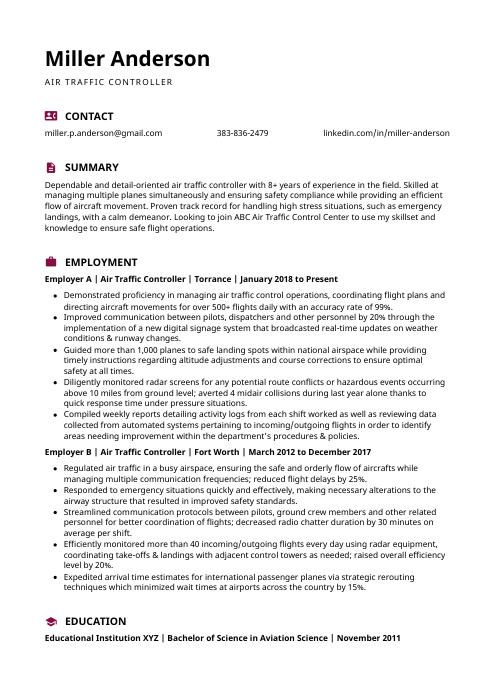 Hoopoe
Hoopoe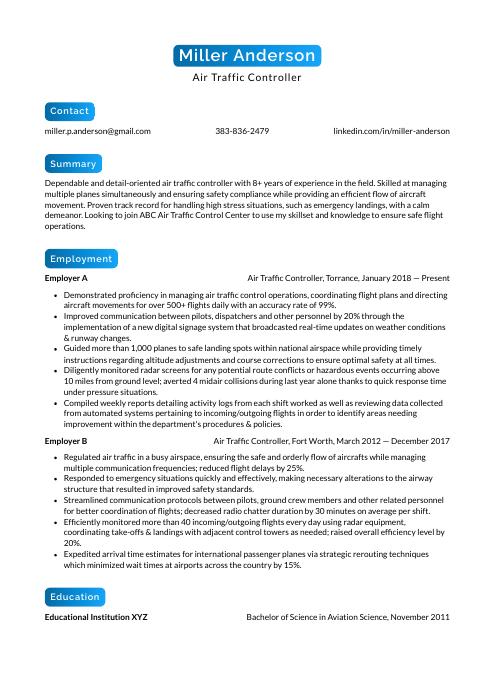 Kinkajou
Kinkajou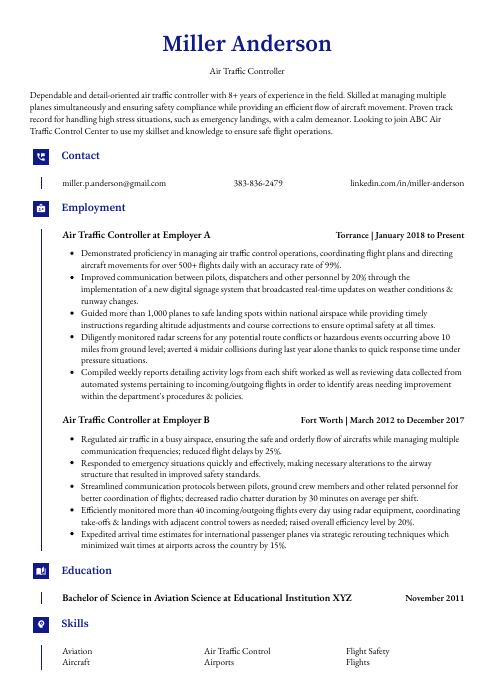 Gharial
Gharial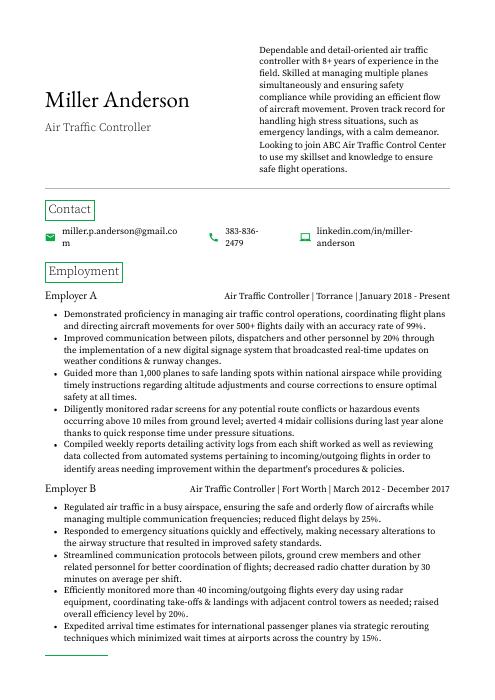 Quokka
Quokka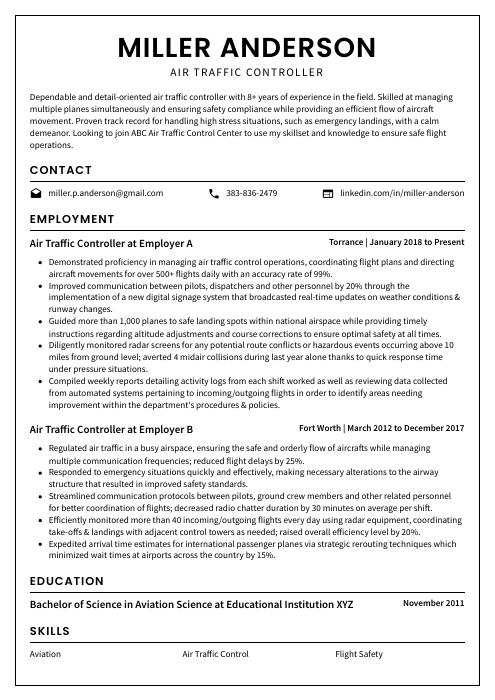 Cormorant
Cormorant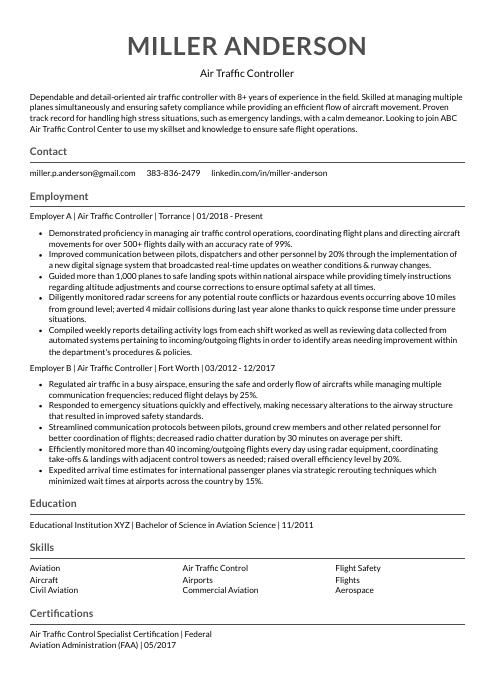 Indri
Indri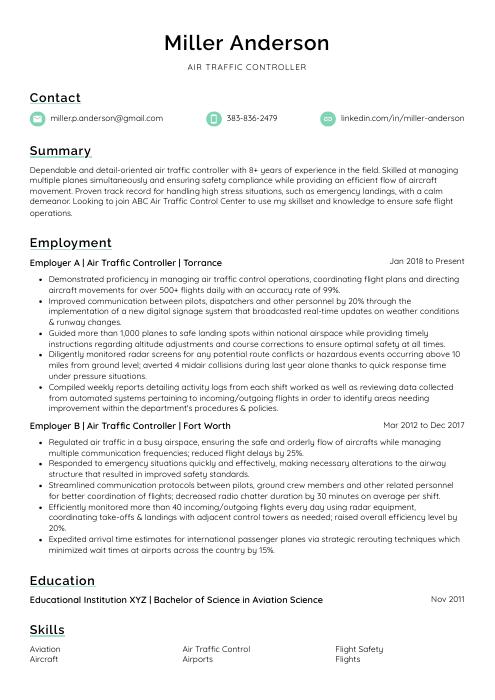 Lorikeet
Lorikeet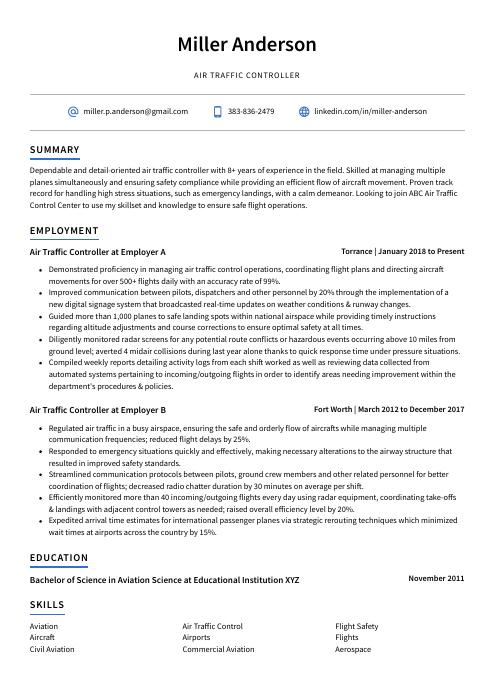 Axolotl
Axolotl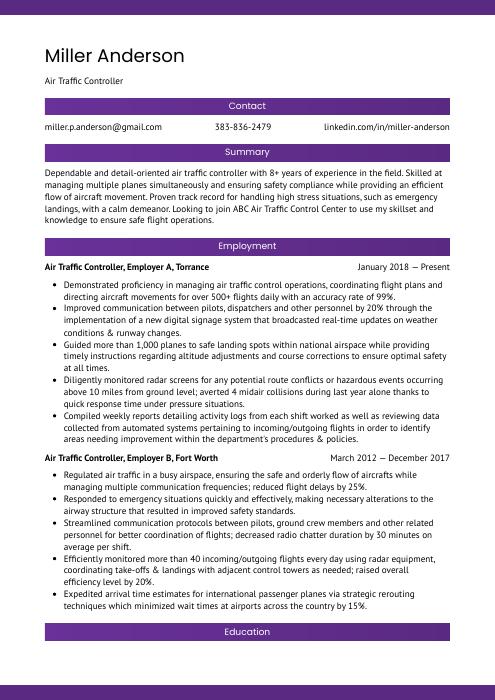 Jerboa
Jerboa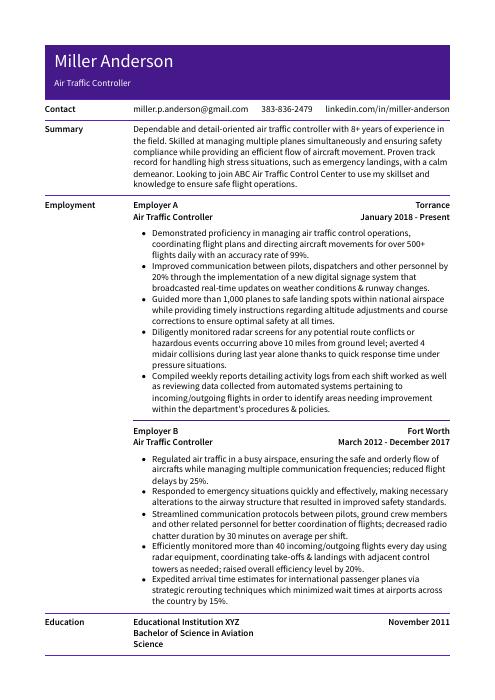 Pika
Pika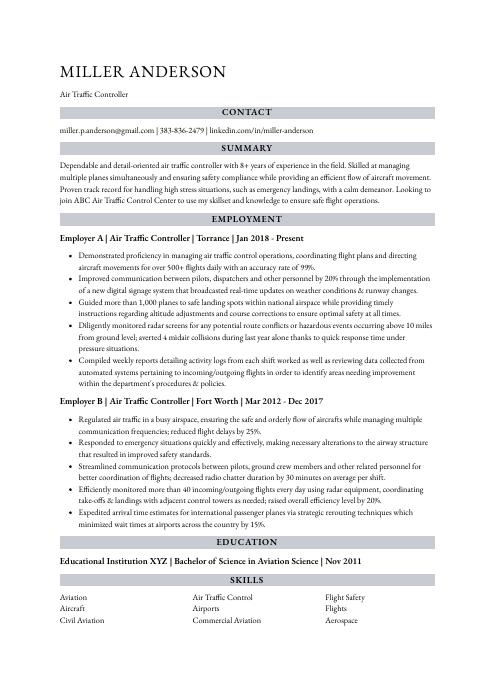 Numbat
Numbat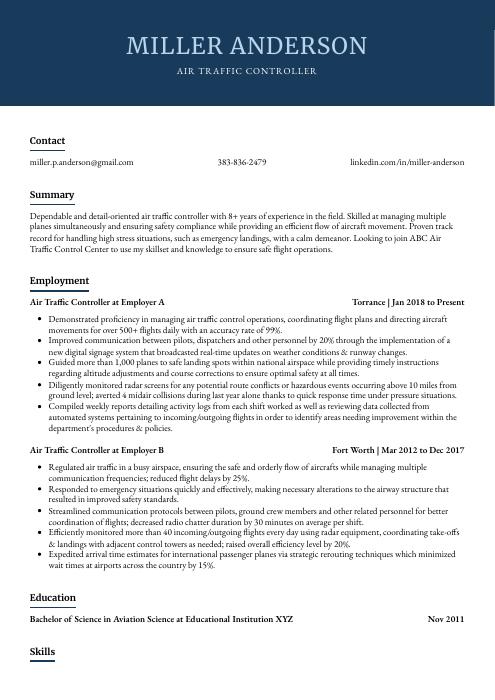 Bonobo
Bonobo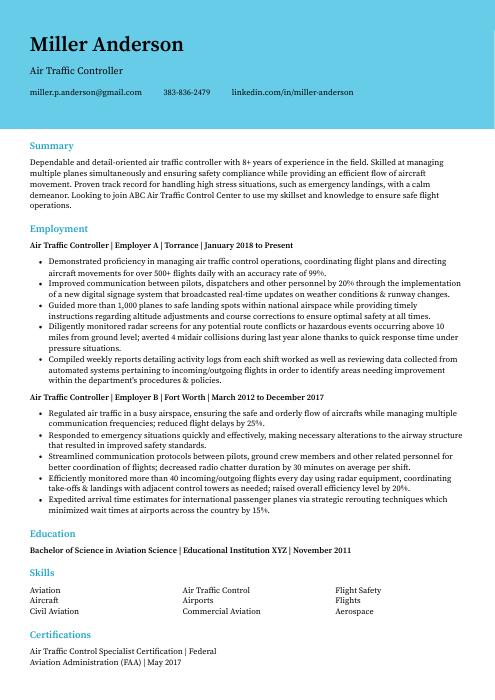 Dugong
Dugong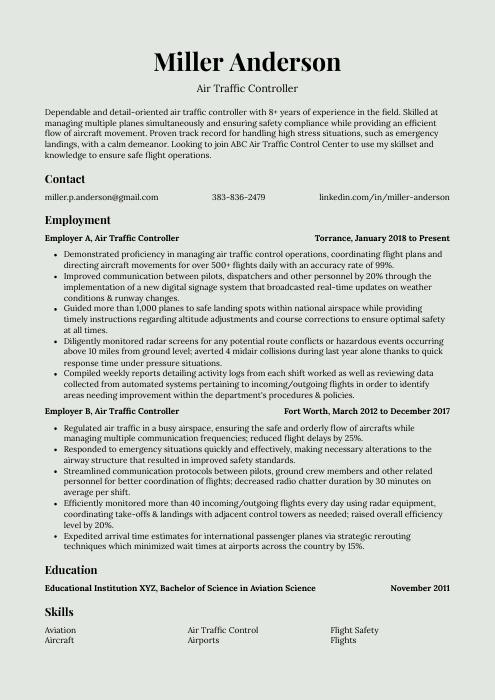 Saola
Saola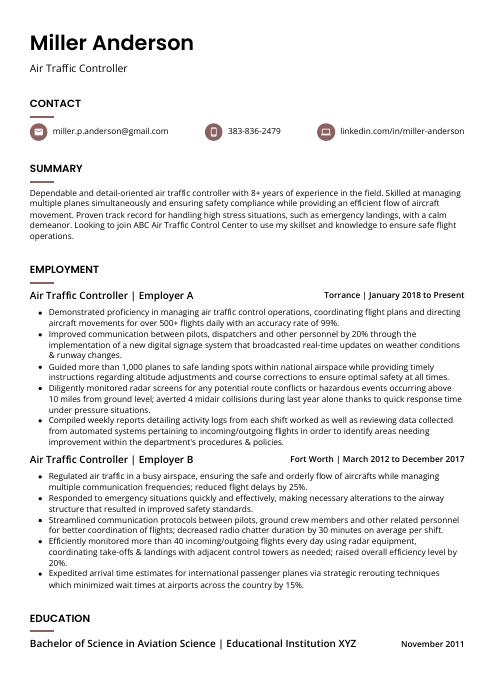 Fossa
Fossa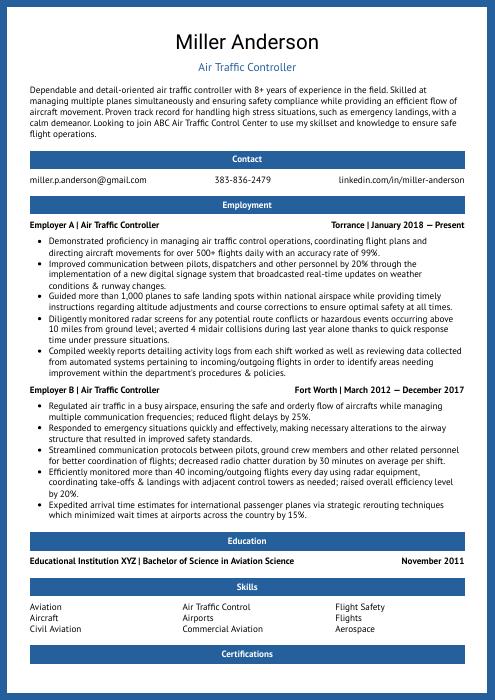 Ocelot
Ocelot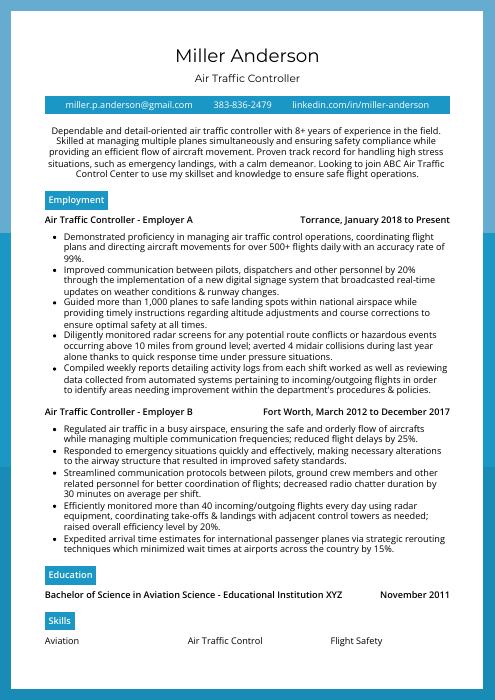 Rhea
Rhea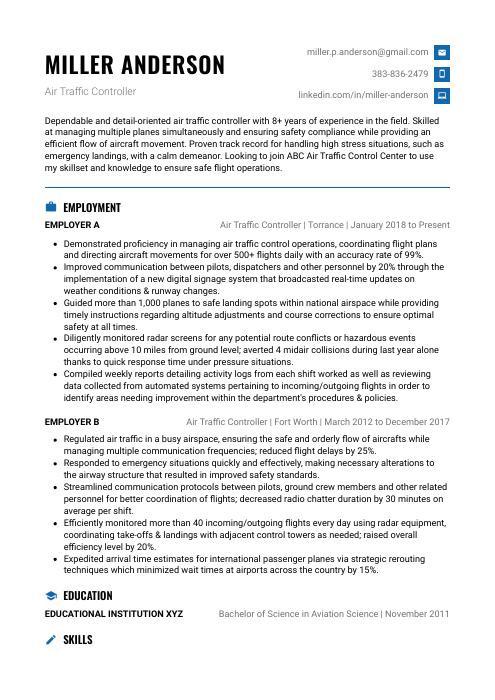 Echidna
Echidna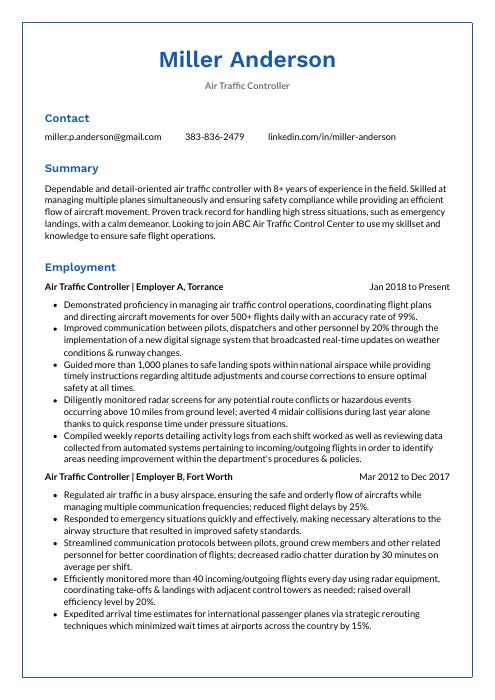 Markhor
Markhor Rezjumei
Rezjumei
